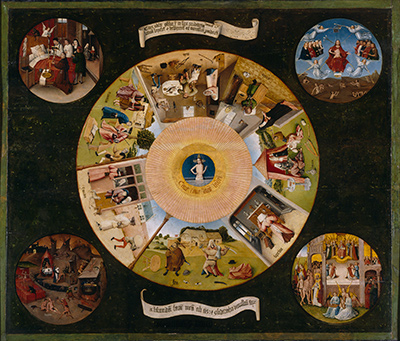The Seven Deadly Sins and the Four Last Things was painted by a follower of Hieronymus Bosch. It consists of a circular series of paintings, all of which were completed using oil on wood.
This is a controversial painting and while its authenticity has been verified, there were several occasions when its origins were questioned.
The Museo del Prado's scholars maintain that the painting was done by Bosch. Yet, the Bosch Research Conservation Project has verified that one of Bosch's followers created it.
The fantastic imagery which is typical of a Bosch painting is seen in the work, as are the narratives. Like other work in Bosch's style, it explores a religious concept, encouraging viewers to examine their life choices and relationship with each other.
The painting is organised into different panels and the one in the centre features the pupil of the eye of God. In it, Christ emerges from the tomb. All around Him are people engaged in the seven deadly sins, starting with Wrath and ending with Pride as the scenes move clockwise from the bottom.
The four corners of the layout show things that people face at the end of earthly life. They include Death Of Sinner and Judgement. Hell may be faced by those who have not accepted Christ's sacrifice for their own sin.
The painting shows those in hell being tortured by demons, which are seemingly quite amused to have the company. This was one of the works collected by Spain's King Phillip II, who may have found the concepts presented interesting food for thought.
Phillip II was a noteworthy collector of art and he added significantly to the impact the arts had in Spain. He was persistent in seeking out works from Bosch and several other artists of the time who presented interesting ideas. The Prado is now the home of much of Bosch's work.
Hieronymus Bosch had a number of followers, even though his work was sometimes thought of as a bit pessimistic in nature. He had a tendency towards macabre portrayals of hell.
With his talent and the fantastic imagery he was able to use in each one of his pieces, these left a lasting impression on many viewers. His fantastical style had a tremendous influence on artists in the north and the Netherlandish Renaissance painter Pieter Brugel the Elder was one of his most famous students.
Bosch's work often focused on one of humanity's fears. Perhaps in doing so, the artist hoped to stir introspection. The Garden Of Earthly Delights like The Seven Deadly Sins and the Four Last Things, compares temporary hedonism and lasting pleasure. Even now, some viewers are confounded by Bosch's work. They do not know what to make of the people cavorting with mermaids in The Garden of Earthly Delights.
Interestingly, literal representations of sin are used in The Seven Deadly Sins and the Four Last Things. This is unlike Bosch and is perhaps one of the reasons why the Bosch Research Conservation Project states that the painting was conceptualised by one of the artist's followers. People who examine the artwork can clearly see sins like Wrath and Greed, along with the eye of God in the centre watching everything.
The punishments are depicted in the work as well. While this painting is fairly literal and easy to understand, the artist also used several symbols right throughout it. Pots of gold are used to boil those sent to hell for being greedy and a mirror is put before a prideful woman by a demon as a punishment for what consumed her.
The Seven Deadly Sins and the Four Last Things may not seem to be as grotesque as some of the other work connected with Bosch. In The Haywain, a cart is pulled by rat-headed creatures while men and women fight to join the lovers cavorting on top of the pile. The cart is headed straight to hell. The destination is not obvious in that panel but in the next, the damned are hung to roast or gutted. This imagery is not for the faint of heart.
Fans of Salvador Dali and Edvard Munch may find some similarity in their work and Bosch's paintings. This is because Bosch helped to influence these artists, along with painters like Pablo Picasso and M.C. Escher. Bosch's hybrid creatures are seen in several of the works which can be directly attributed to Bosch. The Seven Deadly Sins and the Four Last Things is not the only piece that may have been painted by one of his followers. There are at least a dozen paintings which could have been done by his workshop.
While Bosch is associated with the macabre, his sense of humour shines through in many of his works. His painting The Extraction of The Stone of Madness shows a motley crew removing the stupid stone from a man's head. Some of the scenes in the The Seven Deadly Sins and the Four Last Things poke fun at the things that consume people as well. The painting seems to ask if the efforts to indulge so heavily in gluttony or pride are really worth it in the end.




